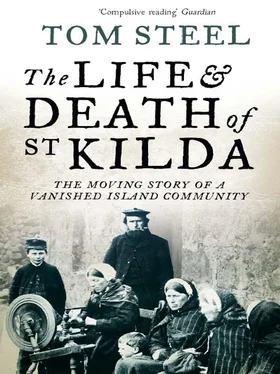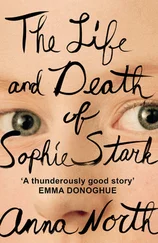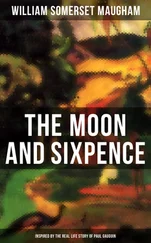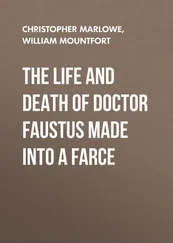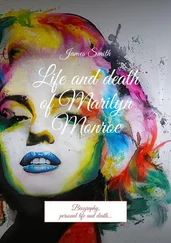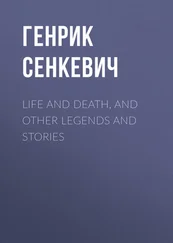A man’s share equalled one boll, which was the equivalent of 140 pounds of flour or oatmeal. After the supplies were distributed, anything left was given out to each household in shares applicable to smaller quantities.
The supplies of tea and other commodities brought to the island by the factor were distributed in a similar way. Potatoes, for instance, were shared on the same basis as meal and flour. Only sugar was an exception. An equal share was given to both young and old, and if preference was ever exercised it was in favour of the younger members of the community.
In later years, the division was calculated more simply. One share was allotted to each adult islander and a half share was given to children of sixteen years and under.
The islanders were equally equitable when it came to sharing gifts donated by tourists and well-wishers. All that arrived on the island was divided, just as every St Kildan was prepared to distribute domestic wealth. If the St Kildan sought anything in life, he sought to be fair.
‘The mental constitution or social polity of the St Kildans’, wrote Wilson, ‘consists in their tenacious adherence to uniformity – no man being allowed, or at least encouraged, to outstrip his neighbours in any thing leading rather to his own advantage than the public weal.’ In some respects, the communal system stifled initiative. ‘I myself’, wrote John Ross the schoolmaster in 1889, ‘heard one man expressing a desire to have one end of his house floored with wood so as to make it more comfortable, but he had to give up the idea, some of the others coming down on him with most peculiar arguments leading him to understand the folly of his plan.’ The wife of the last missionary sent to St Kilda recalls: ‘When the St Kildans started doing something, they all did it on the same day. If they killed a sheep, it wasn’t enough for them to kill one sheep for maybe the whole community. No, every house had to kill a sheep. So there was a piece of mutton landed from each house at the manse. You had mutton till you were fed up with the sight of it.’
The socialist system, whatever its faults, was the direct result of the condition in which the St Kildans found themselves. Common survival was the prime concern and although many from the mainland saw fit to criticize the islanders in latter years because, they claimed, the St Kildans lacked initiative, such a human quality was alien to a people who always thought in terms of the whole rather than the part. It was not that the people of Hirta were ignorant, it was simply that the concept of individualism was not applicable, as far as they were concerned, to the set of circumstances they faced.
In the careful ownership of the MacLeods the social and economic structure changed little for over six centuries. But people may have lived on Hirta for possibly two thousand years. The beehive-shaped stone and turf structures in Glean Mor suggest that in prehistoric times a pastoral people may have lived there. Possibly as a result of changes in climate and the lie and content of the soil, they found it necessary to abandon the settlement. Perhaps those early St Kildans were wiped out by disease or forced off the island by those who at the same time or at a later date chose to live in Village Bay. Whatever happened in those early times is unknown, and it is unlikely that the thin, stony soil has many secrets to give up when archaeologists ultimately dig.
In the eighth century the Norsemen invaded Scotland. For four centuries they ruled the islands of Scotland, and lone St Kilda may well have been part of their empire. In 1886, Richard Kearton and his brother Cherry found earthenware pots similar to those used for cooking purposes in Viking times. Many St Kildan place-names, moreover, have their origins in Norse. Oiseval is derived from the Norse austr fell, meaning ‘east hill’; Soay gets its name from Saud-ey, Norse for ‘sheep isle’. In practically all cases, however, the Viking names apply only to landmarks that can be clearly seen from the sea.
The names of those places the discovery of which requires a landing on Hirta are mostly Gaelic in origin. The names of streams and wells, for instance, derive from the ancient language of the Celts. It could therefore be argued that although the island group was known to the Norsemen, they did not permanently settle on St Kilda. It seems likely that the islands were known to them as a place of shelter in a storm and as a source of supplies of fresh water.
The rule regarding place-names, however, is not a hard and fast one. Many names, such as Mullach Bi and Dun, both easily visible from the sea, are Gaelic; one of Hirta’s fresh water wells, Tobar Childa, gets its name in part from Norse. All that can be deduced with certainty is that St Kilda was known to the Norsemen.
Whatever the origins of the early peoples of Hirta, by the middle ages feathers and the oils extracted from sea birds were valuable commodities. To the owner of St Kilda, therefore, the repopulation, or perhaps population of the island, was the result of economic considerations.
The inhabitants of documented times were descended from those who had been born on the adjacent isles of Lewis, Harris, Skye, and North and South Uist. They were, without doubt, Celtic in origin. Although it seems unlikely that the St Kildans were the descendants of ‘pyrates, exiles or malefactors who fled from justice’, as was thought by the Reverend Kenneth Macaulay in 1758, it is probable that MacLeod of MacLeod occasionally sent the discontented to the most remote part of his territory.
The community must have had several injections of new blood during its long history. Some were necessary, others were totally unexpected. Disease practically wiped out the population twice in the history known to us, and the proprietor, anxious to have such a profitable outpost of his estate inhabited, must have encouraged or cajoled crofters from less remote parts of his empire to populate the archipelago. Many ships were wrecked around St Kilda, more visited the islands whilst fishing the rich waters that surround the group and sailors must have taken a fancy to local girls, jumped ship and settled upon the island.
Many writers tried hard to discover physical peculiarities that would illustrate the difference between the St Kildan and the generality of mankind. ‘As a race’, wrote the Reverend Neil Mackenzie in the nineteenth century, ‘the natives now are under-sized and far from being robust or healthy. They are generally of slender form, with fair hair and a florid complexion.’ There is little real evidence, however, that the islanders differed from their neighbours on the Long Island, or that they were less strong. If the St Kildans exhibited any characteristic worthy of note it was that, from an early age, their faces were quick to show the harshness of life on the island. Towards the end of the community’s history, the people seem to have become more susceptible to cuts and grazes, colds and headaches, but their physical prowess did not appreciably decline and any physical deterioration must be attributed to the general decline of the St Kildan way of life.
The personal qualities of the people of Hirta attracted even more attention than their appearance. Apart from their ignorance, which bemused many a visitor, the St Kildans were thought by many observers to be stubborn, superstitious, lazy and greedy. ‘A total want of curiosity, a stupid gaze of wonder, an excessive eagerness for spirits and tobacco, a laziness only to be conquered by the hope of the above mentioned cordials, and a beastly degree of filth, the natural consequence of this renders the St Kildan character truly savage,’ was Lord Brougham’s conclusive description of the average islander in 1799.
The people of St Kilda, however, like those of many primitive communities, possessed remarkable qualities. They were strong of character, and the unique way of living that evolved reflected to a great extent their almost inexhaustible fund of common sense. ‘They are at heart a kindly disposed people’, wrote Nicol, ‘who mean well, and while you are with them you are one of them. They are extremely solicitous for your welfare; indeed those who have lived for some time in their midst say that it is almost embarrassing when they call each morning to ask if you are well, if you have had a good night’s sleep, and if they can do anything for you.’
Читать дальше
